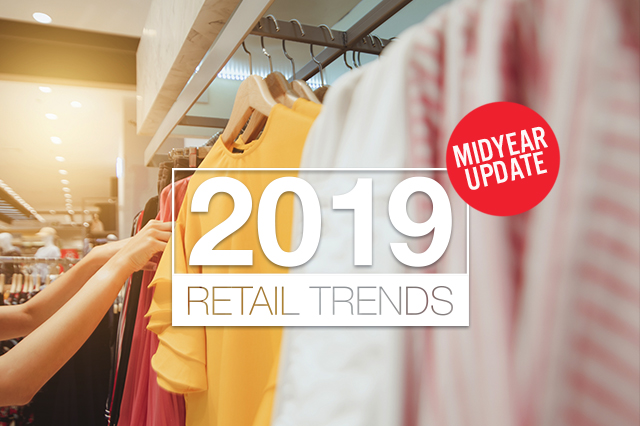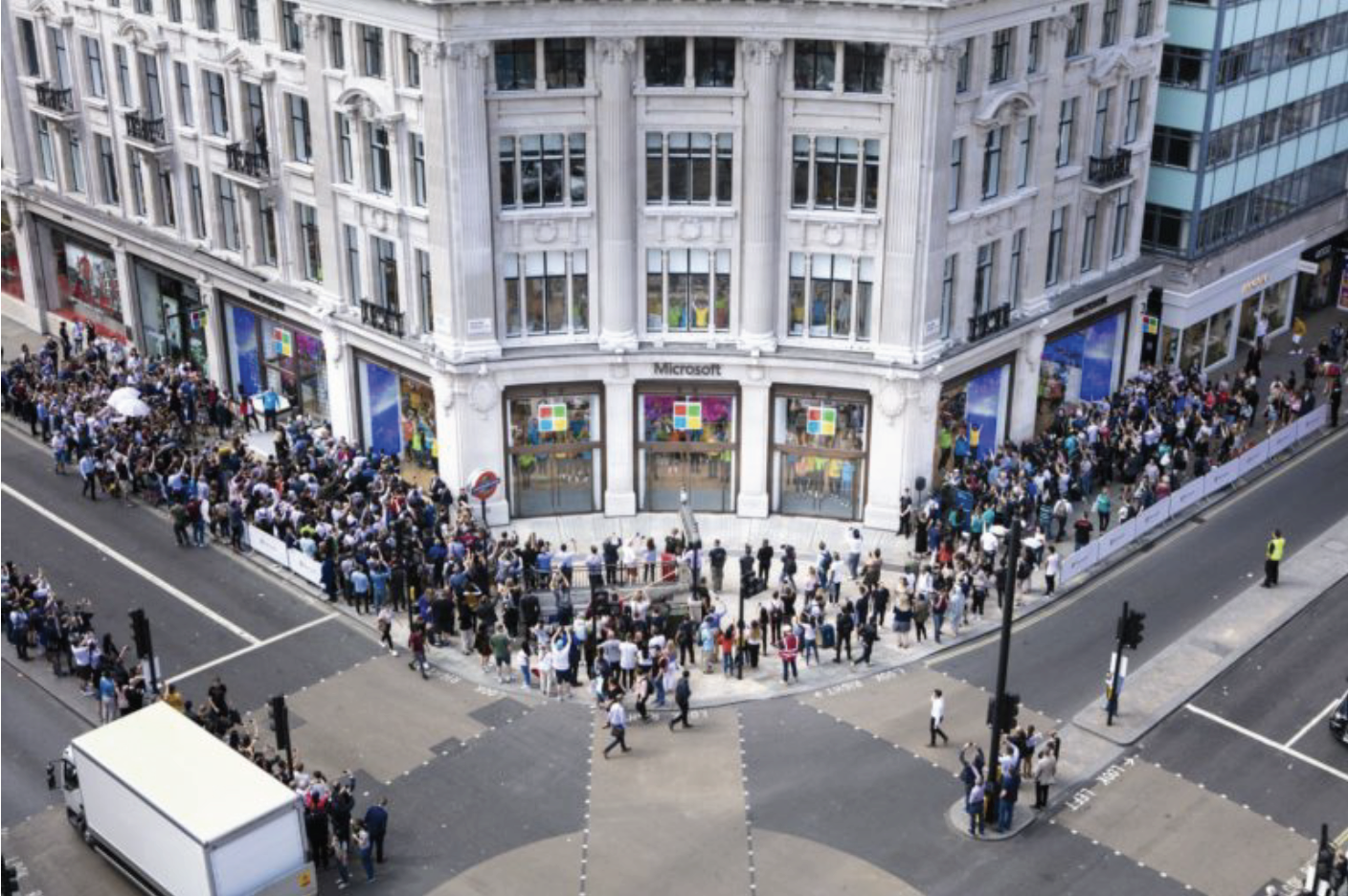
albert Chan
Our 10 Trends for 2019
At midyear, we take stock of the major trends we identified in January to see how they have played out in global retail in the first half of 2019, and identify two new trends we think will be significant in later 2019 and into 2020. This report updates our report 10 Retail Trends for 2019: Get Ready for Retail Reinvention.
These are our 10 global retail trends for 2019 that we identified in January:
- Cities will see more spectacular retail from a new generation of flagship stores.
- “Fast Retail” will be marked by shorter leases, more shared spaces and more short-term stores.
- Western retailers will borrow from “New Retail” with data-driven online-to-offline ventures.
- Technology will continue to strip friction from brick-and-mortar retail.
- Artificial intelligence will become retailers’ go-to technology.
- Startup partnerships will fuel new product development, digital improvements and operational efficiencies.
- Supply chains will become more responsive, and switch from lines to loops.
- More consumers will seek out environmentally and socially engaged brands.
- Shoppers will increasingly expect “Smart Retail” interactions.
- Consumers will look for more inclusive offerings, impacting the apparel and luxury markets.
In the following sections, we discuss the five trends that we have seen make the most timpact so far, and we introduce two new trends that we think will have an impact in the coming months.
Our Top Five Trends So Far in 2019
1. Cities will see more spectacular retail from a new generation of flagship stores.In January, we predicted a new wave of investment in physical stores would be a the core of the reinvention of retail. Urban consumers will enjoy access to these “temples to brands” — experience-rich stores offering a huge choice of product and add-ons such as customization and personalization. The emergence of spectacular retail reflects single-brand retailers’ recognition that stores are as much about building the brand as about generating sales.
This is a trend we see worldwide, but so far this year, we have seen a flurry of acitivity in the UK alone:
- Primark opened its biggest ever store in the city of Birmingham. Moving away from a no-frills concept, the 160,000-square-foot store includes a Disney-themed café and shopping area, a nailbar, a hair and beauty salon and barbers.
- Microsoft opened a flagship store on Oxford Circus, London, in July — its first UK store and located just yards away from Apple’s flagship Regents Street store. Like the nearby Apple Store, the 22,000-square-foot Microsoft Store allows shoppers to touch and try tech products such as Surface, Windows, Xbox and HoloLens, get support from store associates, and attend free workshops on technology.
- Just across from the Microsoft store on Oxford Circus, Nike has continued to invest in its Niketown London store. In June, it reopened its women’s department with a greater emphasis on personalization and service, and featuring technologies that had been previously shown only in its Los Angeles, New York and Shanghai stores. These include “Scan the Look” which allows customers to scan QR codes on mannequins to request showcased items. The department also includes an “Experts Area” staffed by Nike employees to fulfill customization requests, offer assistance and check out customers. Services offere include personal styling and shopping advice.
 Microsoft's new London flagship store
Microsoft's new London flagship storeSource: Microsoft[/caption] 3. “Fast Retail” will be marked by shorter leases, more shared spaces and more short-term stores.
At the start of the year, we predicted the physical retail landscape will change at an accelerated pace as shoppers demand newness, brands — including digital-first brands — seek short-term physical touchpoints, and legacy retailers look for greater flexibility. We’ll also see greater collaboration between retailers, notably in sharing spaces to create traffic-driving synergies, as well as large-store retailers seeking co-tenants to repurpose excess space.
We have seen the fast retail trend play out with a glut of luxury pop-ups in Asia; but the trend for short-term retail space is global.
- In February, luxury brand YSL set up a pink-themed pop-up store in Hong Kong’s central business district. Visitors could shop and take part in games at the pop-up.
- Between January and March, Prada presented Prada Wonderland, an exclusive pop-up installation at the Galaxy Macau. The pop-up installation stocked a selection of leather goods and accessories for men and women, giving customers an opportunity to purchase exclusive products.
- LVMH-owned skincare brand Guerlain recently launched a pop-up to promote its Abeille Royale skincare at Changi Airport in Singapore.
- Amazon will open a series of 10 pop-up stores in the UK featuring independent brands and retailers (even as Amazon closes 87 pop-up kiosks in the US).
We predicted retailers would turn to technologies that remove traditional pain points of brick-and-mortar retail. We see this trend playing out most visibly in grocery — because of its frequent, nondiscretionary nature.
- In January 2019, Kroger announced a partnership with Microsoft and unveiled two new pilot stores named Smart Super Market. The pilot features an upgraded self-scan: Consumers can not only scan items but also make payment using the mobile app.
- Also in January 2019, Kroger announced a collaboration with Microsoft to develop and market a retail as a service (RaaS) platform, which will include a wide array of front- and back-end solutions for third-party retailers.
- In April 2019, Kroger extended its self-drive delivery pilot to Houston. The partnership with Nuro initially uses regular cars outfitted with its auto pilot platform, but will later use its custom-built self-driving robots.
- In June, Carreour opened a trial Amazon Go-style store called Labstore at its headquarters in Massy, France. The store uses sensors and cameras to detect items selected by shoppers; unlike Amazon Go, shopping at Labstore involves a payment stage and the store uses facial recognition to authenticate purchases. In the UK, Tesco is trialling “just walk out” stores using camera technology.
In January, we predicted that demand for more sustainable models would push shoppers toward alternative models of acquisition. Recommerce (resale) platforms and rental services will benefit from the trend of consumers wanting to reduce the environmental impact of their shopping. Brands will increasingly recognize recommerce and rental as acquisition channels, serving as entry points for first-time luxury shoppers.
We have seen resale and rental move further into the mainstream, supported by major fashion names:
- Reflecting demand for resale, online consignment marketplace The RealReal went public in June, raising over $300 million. The company reported 1Q19 GMV of $224 million, up 41.8% year over year. The RealReal also reported that approximately 80% of consignments on its marketplace were sold within 90 days and the sell-through ratio was 96% in 2018.
- In April, H&M announced it would trial selling second-hand and vintage apparel on the website of its & Other Stories brand.
- In May, Urban Outfitters announced it would launch an apparel rental service called Nuuly, allowing US customers to borrow six clothing items per month for an $88 monthly fee.
- A February 2019 Coresight Research survey of 1,037 consumers in the US found that 9% intend to purchase more second-hand luxury clothing or accessories in 2019. A total of 13% of respondents told us they had used online resale websites in the past 12 months.
We predicted brands and retailers would increasingly look to traditionally marginalized fashion customers, most notably plus-size shoppers and those with disabilities looking for adaptive fashion. Aspirational brands will seek to showcase their inclusive credentials through engagement with nontraditional, “body-positive” influencers and celebrities.
Major names continue to embrace greater inclusivity:
- Apparel segments such as bridalwear and sportswear are seeing an increase in plus-size offerings. In April 2019, Torrid created a wedding dress collection priced below $200. The collection is designed exclusively for sizes 10 to 30 and includes all wedding day essentials.
- In June 2019, Nike introduced plus-size and para-sport mannequins for its sportswear displays in its redesigned London store. Nike said the aim was to “celebrate the diversity and inclusivity of sport.”
- In June, Kohl's announced it will add adaptive clothing — apparel designed for people with disabilities — to its three largest childrenswear private labels — Jumping Beans, SO and Urban Pipeline.
Two Trends We Expect to Play Out in the Second Half
We note two trends we expect to see play out in the second half of this year.
1. Legacy retailers will continue to seek our partnershipsIn the second half of 2019 and into 2020, we expect to see legacy retailers seek further partnerships, including with:
- Technology firms to digitalize their businesses. The Kroger-Ocado partnership, being rolled out this year and beyond and the Marks & Spencer-Ocado joint venture, announced earlier this year, are prominent examples.
- Emerging brands to strengthen their product offerings. Recent examples include the launch of Birchbox in selected Walgreens stores and, in the UK, Walgreens-owned Boots selling Harry’s shave products.
- Other retailers and service providers to optimize store space and drive traffic. For example, four Nordstrom stores in Los Angeles are opening Rent The Runway drop boxes; in the US, Kohl’s extended its service this year that lets shoppers return Amazon orders to stores while Rite Aid has partnered with Amazon to offer parcel pick up. And, in the UK, apparel chain Next recently agreed to offer a similar parcel pick-up service for Amazon.
- E-commerce marketplaces to diversify their channel presence. In the US, Chico’s announced this year it would sell on Amazon.
As part of this trend, we expect to see more retailers consider collaborations with companies that have hitherto been considered rivals, such as direct competitors and technology firms such as Amazon. As competitive pressures intensify further, a growing number of longstanding retailers will consider more radical partnerships.
2. Marketplace giants’ shopping festivals will continue to add spectacle and scaleSingles’ Day, Prime Day and the 6.18 Midyear Shopping Festival are now fixed events on the retail calendar. This year, these events will be (or have been) bigger in scale, and more entertaining and engaging than ever.
- Amazon extended Prime Day from 36 hours in 2018 to 48 hours this year. We estimate Amazon generated global product sales of over $5 billion on Prime Day 2019, up from our $3.9 billion estimate for 2018. Again this year, Amazon is leveraging its Whole Foods store network to offer savings in brick-and-mortar retail. Apparently borrowing elements from Alibaba’s annual televized Singles’ Day Gala, on July 10 Amazon live-streamed a star-studded Prime Day-themed concert (ahead of Prime Day).
- During the 6.18 shopping festival in China, JD.com saw total transaction volume of around $29 billion from June 1-18, 26.6% higher than last year. By 8:00 pm on June 18, JD.com reported sales of mobile phones had increased 357% year over year, with books gaining 525% and beauty and skin care growing 412%.
- We await news from Alibaba on the shape of this year’s Singles’ Day event — but the trend suggests we will see more entertainment and more offline engagement.
- Meanwhile, brick-and-mortar retailers are looking to drive excitement with new calendar events, too: for example, Macy’s and Petco now offer “Black Friday in July.”
This year and beyond, we expect digital giants to continue adding spectacle, engagement and anticipation to shopping festivals and to build out the “real-world” elements of these calendar events. Just as physical retail is embracing “spectacular retail” to enhance the shopper experience and drive brand loyalty, marketplaces are adopting an equivalent strategy through shopping festivals. Brands and retailers selling on marketplace sites must be ready to take advantage of the opportunities offered by Singles’ Day in November, and Prime Day and 6.18 in 2020.